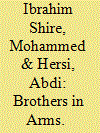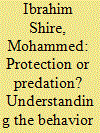|
|
|
Sort Order |
|
|
|
Items / Page
|
|
|
|
|
|
|
| Srl | Item |
| 1 |
ID:
188031


|
|
|
|
|
| Summary/Abstract |
Globally, the spread and use of suicide bombing attacks have become a regular occurrence. Suicide terrorism literature focuses primarily on conventional suicide bombing attacks. However, a growing trend has been observed in the adoption of complex suicide attacks. Using Al-Shabaab as a case study, this paper investigates the phenomenon of complex suicide attacks. We explore the tactical differences of complex suicide attacks vis-à-vis simple attacks in terms of its target goal, discriminative lethality, and delivery method. The paper relies on a uniquely constructed dataset of the group’s suicide operations, employing a variety of data collection techniques. The findings reveal that, inter alia, complex suicide attacks reduce civilian casualties compared to simple suicide attacks. Contrary to the group’s intent and official guidelines to target foreign entities; findings illustrate that domestic targets bear the brunt of most complex suicide attacks. These findings have the potential to contribute to counter-terrorism strategies and be adopted by concerned states in order to effectively protect significant loss of lives and destruction of property resulting from suicide terrorism.
|
|
|
|
|
|
|
|
|
|
|
|
|
|
|
|
| 2 |
ID:
191470


|
|
|
|
|
| Summary/Abstract |
Targeted killing is a cornerstone of counter-terrorism strategy, and tactical mistakes made by militant groups are endemic in terrorism. Yet, how do they affect a militant group’s suicide bomber deployment? Since joining Al-Qaeda, Al-Shabaab has carried out various types of suicide attacks on different targets. Using a uniquely constructed dataset, I introduce two typologies of suicide bomber detonation profiles – single and multiple – and explore the strategic purposes these have served for the group during multiphasic stages following targeted killings against the group’s leadership and targeting errors committed by Al-Shabaab. The findings reveal that targeted killing has the opposite effect of disrupting suicide attacks, instead, leading to a rapid proliferation of unsophisticated single suicide attacks against civilian and military targets to maintain the perception of the group’s potency. Thus, I argue that targeting errors made by Al-Shabaab have a more serious detrimental effect on its deployment of suicide attacks than any counter-terrorism measure.
|
|
|
|
|
|
|
|
|
|
|
|
|
|
|
|
| 3 |
ID:
184184


|
|
|
|
|
| Summary/Abstract |
During civil wars, some communities raise self-defense militias to protect themselves from insurgent predation, but these militias can end up mutating into predatory organizations. The extant literature has focused chiefly on the predatory propensity of state-created self-defense militias and has mostly overlooked why some community-created self-defense militias segue into predatory organizations while others eschew predation altogether. This study explains this phenomenon, drawing on in-depth interviews with active members of two community-created self-defense militias (Ahlu Sunna Waljama’a and Macawiisley) in Somalia. In doing so, two sequential mechanisms (sponsorship and mobility) that determine the propensity of predatory behavior are introduced. Self-defense militias that conduct offensive operations engage in predatory behavior, irrespective of whether they are sponsored locally or have external patrons. Externally sponsored self-defense militias that engage in offensive operations attract opportunistic recruits and become motivated by material benefits, while community-sponsored self-defense militias that conduct offensive operations instrumentalize their position to settle old scores against rival communities. By contrast, self-defense militias that restrict their operations to defensive activities typically recruit dedicated homegrown members, and are regulated by community-managed accountability mechanisms that prevent predatory and abusive behavior. This community control remains crucial for defensive self-defense militias, who must balance external patrons’ strategic aims with their local objectives.
|
|
|
|
|
|
|
|
|
|
|
|
|
|
|
|
|
|
|
|
|